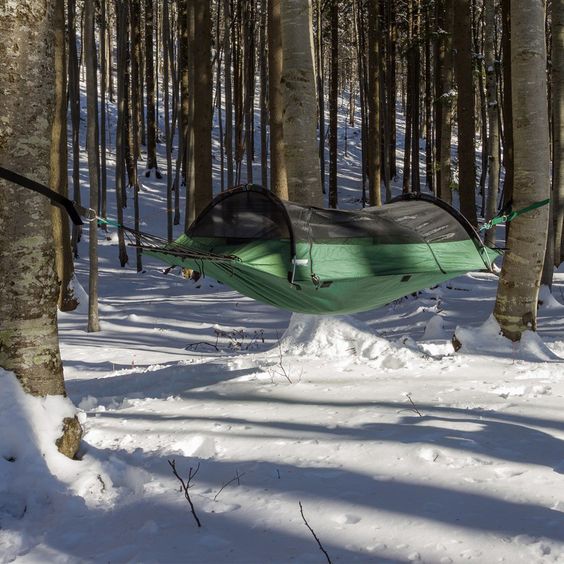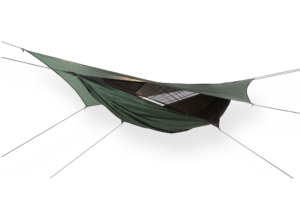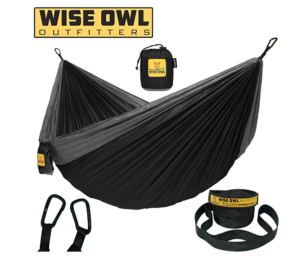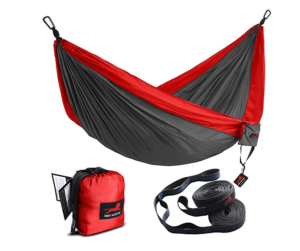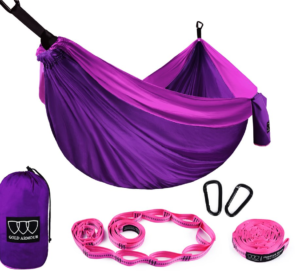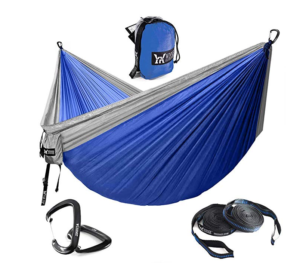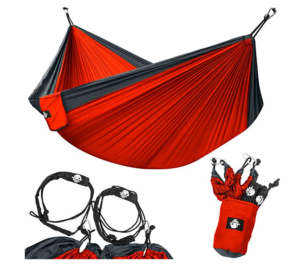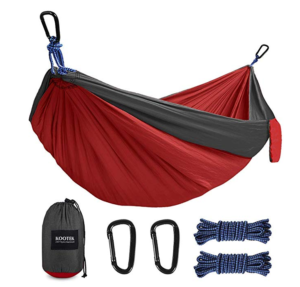Best camping hammocks on the market.
Camping hammocks with Mosquito nets among other great features. Your comprehensive camping hammocks guide for the Best hammock Brands to Buy.
Does nature fascinate you? Do you enjoy getting into close proximity to nature? Would you love to explore deep into the woods to discover that privacy and peacefulness? Nothing can outdo the calmness of waking up to the spectacular beauty of nature.
Hammock camping will always open up your expedition to the unexplored terrain.
Camping creates the bonds between you and nature, to fully get captivated by its attractiveness and feel attached to the planet once more. Camping enables you to unplug from the hustle and bustle of real life.
Best Camping Hammocks
Hennessy Hammock – Expedition Series
|
Wise Owl Outfitters Hammock Camping Double & Single with Tree Straps
|
HONEST OUTFITTERS Single & Double Camping Hammock
|
Gold Armour Camping Hammock
|
WINNER OUTFITTERS Double Camping Hammock
|
Legit Camping – Double Hammock
|
Kootek Camping Hammock Portable
|
Modern Camping and Hammocks
Modern camping is now evolving and it does not have to involve sleeping under canvas tucked inside a tent. Camping these days doesn’t always necessitate you to rest on the floor, dealing with rigid and unequal ground, where sometimes invisible rocks protrude your back in the middle of your sleep.
Camping tents also occupy most of your space and you may end up hitching some camping equipment to create room for that bulky tent. This is where hammock camping comes in and I guarantee you that it will entirely make different your way of camping. camping hammocks are also super simple to set up anywhere and at any time as they are lightweight and therefore convenient to carry. I also promise you that it will be a life-changing experience.
FAQs
Now you’ve purchased the ideal hammock, you adore it and so do you your family members and friend. Nonetheless, you may have a number of questions in relation to your new piece of relaxation.
We are here to assist you to get to answering those queries. Read on to find out the response to most of the frequently asked questions.
- Can one leave their hammock outside in the snow during the winter?
We advise that you keep your hammock in a cool and dry place during the winter months. This will, in turn, give your hammock a lengthy life and it will be available for you to put up come next spring. Hammock stands can also be fairly effortlessly disassembled as well for keep the purpose
- Is it advisable to leave my hammock outside for the whole period of summer?
It normally is recommended that you always put your hammock inside a house or store it when it is not being used. Doing this will reduce the level of exposure to the elements such as excessive heat and sunlight which may end up damaging your hammock. Shielding your hammock from such elements will, in turn, prolong your hammock’s lifespan.
- Can all hammocks hold more than one person?
The number of people a hammock can carry mainly depends on the given maximum weight capacity of that hammock. It is the role of the user to make sure that they always put up with the given maximum capacity so that their safety is not put at risk and also so that the hammock is not damaged. The maximum weight bearing of your hammock should always be incorporated on an instruction sheet that comes with your hammock or on the packaging of your hammock
- How much will my hammock stretch?
Depending on the material in which the hammock is made of most hammocks are elastic and are therefore able to stretch to some feet.
- How to clean a hammock?
For the hammocks that have spreader bars, you are advised to wash them using a mild detergent and water in a bathtub and then air dry it. For the quilted and fabric hammocks use a scrub brush, mild detergent, and water, scrub, hose it off completely and hung it to air dry.
For hammocks, without spreader bars, they can be machine washed on a gentle cycle but first should be put in a lingerie bag or pillowcase with the ends of the hammock tied together. (If you use a pillowcase, you should also tie the ends of the pillowcase together before placing it in the washing machine.)
What are the safety precautions that I should take into account when using my hammock?
Always ensure that you do not exceed your hammock’s maximum weight capacity. When your children are using your hammock always ensure that they have adult supervision. When your kids are using the hammock restrict them from playing in it. Playing in this matter involves jumping, walking or spinning in the hammock. Permitting them to play in the hammock could turn out to be extremely dangerous.
Always make sure that hammock chains never become twisted and be cautious not to overturn your hammock over while it is hung; doing either of these can cause the chain strength to weaken.
Be sure to always check your hammock before getting into it. Birds, rodents, and bugs tend to use hammock rope fibers to build nests; if the rope is impaired with it may be dangerous.
- My hammock is getting looser as the days go by and when I lay on it I am closer to the ground than I used to be. How do I raise it higher again?
Hammocks are known to naturally stretch. To try to fix this, tighten the hammock by moving the chains on your hammock’s end loops. You may fail to be able to adjust the chains if your hammock is of old age; if this is the case, try to enlarge the distance between the two posts or adjust the height if your space allows. Unfortunately, this could also be a sign that your hammock is nearing the end of its useful life and it may be time for you to get a new one.
Factors to Consider When Choosing the Best Camping Hammocks
- Size
There usually are two sizes of the hammock, the double and the single sizes. Many people mainly prefer the double size hammocks mainly for comfort reasons.
- Accessories
You will need the following items when setting up your hammock; suspension straps, a net for bugs and an under quilt for cool localities.
- End-Use
If you are looking for a hammock for use during camping or hang out times durability aspect matters a lot but if you are looking for one for backpacking reasons its weight is the key consideration.
Advantages of Camping Hammocks
Doing a comparison between going for camping hammocks or camping tents, I would recommend the use of camping hammocks. These are some of the advantages of camping hammocks
High quality of sleep and camp comfort
Most people camping find sleeping in a hammock more comfortable in comparison to sleeping on the ground, or at least as good. A comfortable night of rest allows one to recover better and wake up refreshed, therefore, hike more the next day. Different from the ground system, this increase in sleep quality is not in opposition to a lightweight pack.
A hammock also serves as an outstanding camp seat and therefore provides no need to bring a dedicated camp chair.
Consistent setup
Camping Hammocks can be unchangingly put up the exact same way, night after night or day after day. Differently, the ground camping differs nearly every night due to ground sloping, ground cover, and surface abnormalities. Therefore, it’s much easier to master the put up and also a person can reliably sleep similar way or at the same position each and every night.
Privacy
When one wants to get away from populated camping areas to find peace and quiet, and a better night of rest Hammocks are always s blessing to those who do not desire the crowded scenes. Most times when better campsites exist that are more aesthetic, more protected, less buggy among other factors one will always want to utilize the
Fast Setup
Most times a person sets up a hammock within a shorter period than a ground system. When camping on the ground, one must first find out a suitable area and then remove all the rocks and all other debris, therefore, consuming a lot of time. In contrast, putting up a hammock involves clipping two nylon straps around trees — a process that takes an experienced hammock camper just a minute or two.
Hammock camping leaves no trace
If you are practicing Leave No Trace (LNT) it is always easier while using a hammock:
Hammocks usually do not crush or smother the plants below them as it happens in ground camping
To avoid impacting trees, I would recommend that wide tree straps should be used. Most of all backpacking hammocks are usually sold with this type of strap.
Easy accessibility of water
Most of the times it is quicker and more convenient to camp near a water source, for instance, if one is hiking on a ridge where water sources are scarce. With a hammock, one can camp near these water sources even if there are no favorable ground campsites close by.
Protection against rain and groundwater
If it is raining and/or when the ground is wet, a hammock system is always magnificent. The cover provides the necessary protection against the rain, and the hammock can be used as a dry bench seat while I am cooking or relaxing in camp. If the ground is wet a hammock won’t be affected as would have been the case with ground camping.
Disadvantages of Camping Hammocks
Weight
When one compares the heaviness of a hammock system against that of the ground system that of the hammock system is slightly heavier especially those that are used in cold localities.
Limited space
Compared to the big tents hammocks tend to provide slightly less space. This mostly is usually the case because most hammocks are often designed as a one-person shelter.
Difficulty to set up
Learning to set up a hammock camp at first usually takes more time but in the long term when one acquires the skills it turns out to be probably faster than setting up a ground system. There usually is a bit of art to put up a hammock and also to sleep in one
Sleeping comfort
I know I started this as an advantage before but some people usually feel a little squeezed while in a hammock. This is mostly the case where bridge hammocks feel a little tighter compared to the gathered end hammocks
Cold comfort
In most cases, ground sleepers usually find the need to insulate their underside against the ground, mainly by using a closed-cell foam or air mattress. Hammock campers find themselves disadvantaged because of the cooling from underneath, especially if there is a strong wind.
Many of the hammock campers find themselves in this situation and are often forced to provide for themselves effective insulation underneath their hammock, in addition to the existing conventional topside insulation (i.e. sleeping bag) that they usually have. This usually is done by properly installing a sleeping pad, but in most times this ground-inspired product usually does not go well with hammocks. With this under-quilts are mostly settled upon. In cases where the temperatures are extreme, a full-sided tarp to block the wind entirely is also very helpful.
Some know-how and skills are necessary to properly use an under-quilt and to properly pitch a tarp. Once mastered, sleeping warm showcases no great difficulties.
How to use a camping hammock
- Look for strong trees that are about 12-15ft or 3,6-4.6m apart
- Attach 2.5-5cm or 1-2 inches wide webbing straps around the trees you have identified to protect the bark about 1.8metres high i.e. 6ft so as to create attachment points
- Lash the hammock rope directly to the webbing after tying it to a carabiner, looped through a toggle or in any other preferred configuration
- Try a say 30-degree angle from the hammock line to the tree.
- Ensure that you keep the hammock about a chair height this is 31-46 cm (12-18ft) above the ground level
- Ensure that you have hung your hammock evenly between the trees and at relatively equal height mostly if the terrain is not equal.
- Introduce a trap for you to shield yourself against the rains and also wind
Conclusion
With no worry about uneven, wet, muddy, rocky or bug-infested ground enjoy your camping from the comfort of your hammock. You are already in the woods with your hammock but you don’t know how to set it up.
Don’t worry! This guide should help you set up your hammock in the least time possible so that you can now start enjoying your camping experience. Maybe start reading a book you have been dying to start or even rest.
Related
